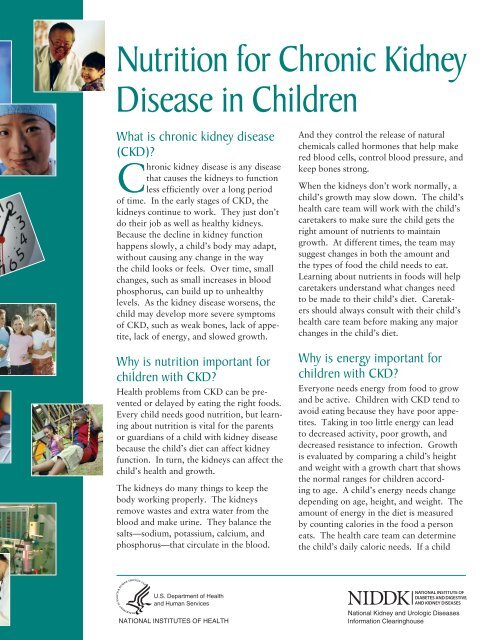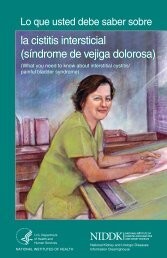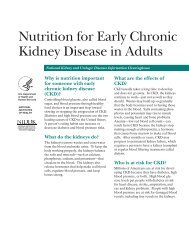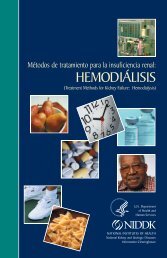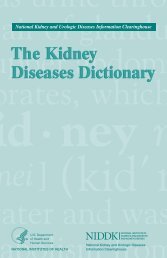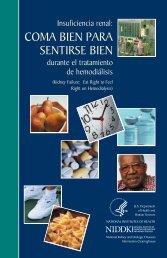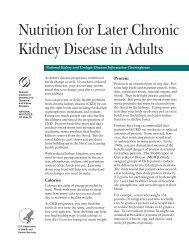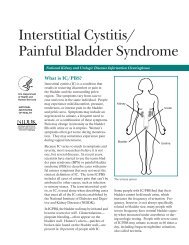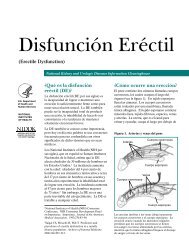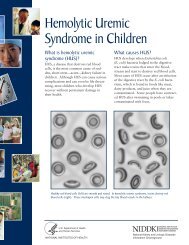Nutrition for Chronic Kidney Disease in Children - National Kidney ...
Nutrition for Chronic Kidney Disease in Children - National Kidney ...
Nutrition for Chronic Kidney Disease in Children - National Kidney ...
Create successful ePaper yourself
Turn your PDF publications into a flip-book with our unique Google optimized e-Paper software.
<strong>Nutrition</strong> <strong>for</strong> <strong>Chronic</strong> <strong>Kidney</strong><br />
<strong>Disease</strong> <strong>in</strong> <strong>Children</strong><br />
What is chronic kidney disease<br />
(CKD)?<br />
<strong>Chronic</strong> kidney disease is any disease<br />
that causes the kidneys to function<br />
less efficiently over a long period<br />
of time. In the early stages of CKD, the<br />
kidneys cont<strong>in</strong>ue to work. They just don’t<br />
do their job as well as healthy kidneys.<br />
Because the decl<strong>in</strong>e <strong>in</strong> kidney function<br />
happens slowly, a child’s body may adapt,<br />
without caus<strong>in</strong>g any change <strong>in</strong> the way<br />
the child looks or feels. Over time, small<br />
changes, such as small <strong>in</strong>creases <strong>in</strong> blood<br />
phosphorus, can build up to unhealthy<br />
levels. As the kidney disease worsens, the<br />
child may develop more severe symptoms<br />
of CKD, such as weak bones, lack of appetite,<br />
lack of energy, and slowed growth.<br />
Why is nutrition important <strong>for</strong><br />
children with CKD?<br />
Health problems from CKD can be prevented<br />
or delayed by eat<strong>in</strong>g the right foods.<br />
Every child needs good nutrition, but learn<strong>in</strong>g<br />
about nutrition is vital <strong>for</strong> the parents<br />
or guardians of a child with kidney disease<br />
because the child’s diet can affect kidney<br />
function. In turn, the kidneys can affect the<br />
child’s health and growth.<br />
The kidneys do many th<strong>in</strong>gs to keep the<br />
body work<strong>in</strong>g properly. The kidneys<br />
remove wastes and extra water from the<br />
blood and make ur<strong>in</strong>e. They balance the<br />
salts—sodium, potassium, calcium, and<br />
phosphorus—that circulate <strong>in</strong> the blood.<br />
U.S. Department of Health<br />
and Human Services<br />
NATIONAL INSTITUTES OF HEALTH<br />
And they control the release of natural<br />
chemicals called hormones that help make<br />
red blood cells, control blood pressure, and<br />
keep bones strong.<br />
When the kidneys don’t work normally, a<br />
child’s growth may slow down. The child’s<br />
health care team will work with the child’s<br />
caretakers to make sure the child gets the<br />
right amount of nutrients to ma<strong>in</strong>ta<strong>in</strong><br />
growth. At different times, the team may<br />
suggest changes <strong>in</strong> both the amount and<br />
the types of food the child needs to eat.<br />
Learn<strong>in</strong>g about nutrients <strong>in</strong> foods will help<br />
caretakers understand what changes need<br />
to be made to their child’s diet. Caretakers<br />
should always consult with their child’s<br />
health care team be<strong>for</strong>e mak<strong>in</strong>g any major<br />
changes <strong>in</strong> the child’s diet.<br />
Why is energy important <strong>for</strong><br />
children with CKD?<br />
Everyone needs energy from food to grow<br />
and be active. <strong>Children</strong> with CKD tend to<br />
avoid eat<strong>in</strong>g because they have poor appetites.<br />
Tak<strong>in</strong>g <strong>in</strong> too little energy can lead<br />
to decreased activity, poor growth, and<br />
decreased resistance to <strong>in</strong>fection. Growth<br />
is evaluated by compar<strong>in</strong>g a child’s height<br />
and weight with a growth chart that shows<br />
the normal ranges <strong>for</strong> children accord<strong>in</strong>g<br />
to age. A child’s energy needs change<br />
depend<strong>in</strong>g on age, height, and weight. The<br />
amount of energy <strong>in</strong> the diet is measured<br />
by count<strong>in</strong>g calories <strong>in</strong> the food a person<br />
eats. The health care team can determ<strong>in</strong>e<br />
the child’s daily caloric needs. If a child<br />
<strong>National</strong> <strong>Kidney</strong> and Urologic <strong>Disease</strong>s<br />
In<strong>for</strong>mation Clear<strong>in</strong>ghouse
2<br />
is not grow<strong>in</strong>g as well as possible, the health care<br />
team can suggest healthy ways to add calories to the<br />
child’s diet. While feed<strong>in</strong>g tubes are most often used<br />
<strong>for</strong> <strong>in</strong>fants, situations occur when older children and<br />
adolescents also benefit from them.<br />
Why is know<strong>in</strong>g about prote<strong>in</strong><br />
important <strong>for</strong> children with CKD?<br />
Prote<strong>in</strong> is an essential part of any diet. Prote<strong>in</strong> helps<br />
build and ma<strong>in</strong>ta<strong>in</strong> muscle, bone, sk<strong>in</strong>, organs, and<br />
blood. Some prote<strong>in</strong>s help fight disease and heal<br />
wounds. All prote<strong>in</strong>s break down <strong>in</strong>to waste products<br />
that must be removed from the blood by the kidneys.<br />
Eat<strong>in</strong>g more prote<strong>in</strong> than the body needs may put an<br />
extra burden on the kidneys and cause kidney function<br />
to decl<strong>in</strong>e faster. The table below shows the prote<strong>in</strong><br />
content of some common foods, by serv<strong>in</strong>g size, listed<br />
from highest to lowest prote<strong>in</strong> content.<br />
Prote<strong>in</strong> Content of Foods<br />
Food Serv<strong>in</strong>g Size<br />
Turkey breast 41 grams/cup<br />
Large hamburger with vegetables<br />
and condiments<br />
34 grams/8-ounce (oz)<br />
sandwich<br />
Tuna sub 30 grams/6-<strong>in</strong>ch sub<br />
Cottage cheese 25 grams/cup<br />
Chili con carne 24 grams/cup<br />
Cold-cut sub 21 grams/6-<strong>in</strong>ch sub<br />
Fast-food taco 20 grams/6-oz taco<br />
Fish sandwich with tartar sauce<br />
and cheese<br />
20 grams/6.5-oz sandwich<br />
Baked beans 17 grams/cup<br />
Chicken nuggets 16 grams/6 nuggets<br />
Yogurt 13 grams/8-oz conta<strong>in</strong>er<br />
Beef stew 11 grams/cup<br />
Fast-food burrito with meat and<br />
beans<br />
11 grams/4-oz burrito<br />
Cooked peas 8 grams/cup<br />
Chicken noodle soup 6 grams/cup<br />
Source: United States Department of Agriculture (USDA)<br />
<strong>National</strong> Nutrient Database <strong>for</strong> Standard Reference, Release<br />
22. USDA website. www.ars.usda.gov/SP2UserFiles/<br />
Place/12354500/Data/SR22/nutrlist/sr22w203.pdf.<br />
Released September 2009. Accessed July 22, 2010.<br />
Doctors sometimes recommend that people with<br />
CKD eat moderate or reduced amounts of prote<strong>in</strong>.<br />
In children with CKD, however, restrict<strong>in</strong>g prote<strong>in</strong><br />
can prevent adequate growth and may lead to malnutrition.<br />
For children with CKD, the goal is to eat<br />
enough prote<strong>in</strong> <strong>for</strong> growth but avoid high prote<strong>in</strong><br />
<strong>in</strong>take.<br />
Caretakers should talk with the health care team<br />
about the amount of prote<strong>in</strong> and the sources of prote<strong>in</strong><br />
<strong>in</strong> their child’s diet. Animal sources such as eggs,<br />
milk, cheese, chicken, fish, and red meats conta<strong>in</strong><br />
more of the essential am<strong>in</strong>o acids the body needs, but<br />
a well-balanced vegetarian diet can also provide these<br />
nutrients. The health care team can suggest dietary<br />
changes to help meet the child’s prote<strong>in</strong> needs.<br />
The follow<strong>in</strong>g table provides the daily prote<strong>in</strong> needs<br />
by age and weight <strong>for</strong> children with CKD.<br />
Age Range<br />
Daily Prote<strong>in</strong> Needs <strong>for</strong><br />
<strong>Children</strong> with CKD<br />
Grams of Prote<strong>in</strong> Needed<br />
per Pound of Body Weight<br />
Predialysis <br />
Hemodialysis<br />
Peritoneal<br />
Dialysis<br />
Infant 0–6<br />
months<br />
1 1.2 1.3–1.4<br />
7–12<br />
months<br />
0.73 1.1 1.0–1.1<br />
Toddler 1–3 years 0.5 0.7 0.9<br />
Child 4–6 years 0.5 0.7 0.9<br />
7–10 years 0.45 0.6 0.8<br />
Adolescents 11–14 years 0.45 0.6 0.8<br />
15–18 years 0.4 Girls Boys 0.6–0.7<br />
0.5 0.6
Because dialysis removes prote<strong>in</strong> from the blood,<br />
a child on dialysis needs to eat more prote<strong>in</strong>. The<br />
amount of prote<strong>in</strong> needed depends on the type of<br />
dialysis. In hemodialysis, the blood is filtered by<br />
flow<strong>in</strong>g through tubes to a filter outside the body and<br />
then back through another set of tubes to the body.<br />
In peritoneal dialysis, the blood is filtered when a<br />
fluid called dialysis solution is dra<strong>in</strong>ed from a bag<br />
<strong>in</strong>to the child’s abdomen, where it soaks up wastes<br />
and extra water from the blood and is then dra<strong>in</strong>ed<br />
from the abdomen. Peritoneal dialysis removes more<br />
prote<strong>in</strong> than hemodialysis.<br />
For example, accord<strong>in</strong>g to the chart, a 10-year-old<br />
boy with pre-dialysis CKD would need 0.45 grams<br />
of prote<strong>in</strong> a day <strong>for</strong> each pound of his body weight.<br />
To f<strong>in</strong>d his daily prote<strong>in</strong> requirement, his weight<br />
<strong>in</strong> pounds should be multiplied by 0.45. If the boy<br />
weighs 60 pounds, he would need 27 grams of prote<strong>in</strong><br />
a day.<br />
[child’s weight <strong>in</strong> pounds] × [value from age chart] =<br />
[daily prote<strong>in</strong> requirement]<br />
60 × 0.45 = 27<br />
Limit<strong>in</strong>g a child to this amount of prote<strong>in</strong> may be difficult<br />
because some foods conta<strong>in</strong> that much prote<strong>in</strong><br />
<strong>in</strong> a s<strong>in</strong>gle serv<strong>in</strong>g. Sandwiches should be cut <strong>in</strong> half.<br />
Smaller portions of soups and vegetables, which also<br />
conta<strong>in</strong> prote<strong>in</strong>, should be served.<br />
If this same boy starts hemodialysis, he will need<br />
0.6 grams of prote<strong>in</strong> <strong>for</strong> each pound of his body<br />
weight. His daily prote<strong>in</strong> needs would go up to<br />
36 grams.<br />
60 × 0.6 = 36<br />
On peritoneal dialysis, the boy’s daily requirement<br />
goes up to 0.8 grams per pound. There<strong>for</strong>e, he<br />
would need 48 grams of prote<strong>in</strong> a day.<br />
60 × 0.8 = 48<br />
A child’s prote<strong>in</strong> needs vary over time, so caretakers<br />
should discuss these needs with the health care team.<br />
Why is know<strong>in</strong>g about sodium<br />
important <strong>for</strong> children with CKD?<br />
Sodium, a m<strong>in</strong>eral, is important <strong>for</strong> many body functions.<br />
In some children with CKD, too little sodium<br />
can lead to dehydration and poor weight ga<strong>in</strong>. On<br />
the other hand, too much sodium can <strong>in</strong>crease thirst,<br />
raise blood pressure, and cause water retention that<br />
may lead to excess weight ga<strong>in</strong> or fluid buildup <strong>in</strong> the<br />
lungs.<br />
Sodium is found <strong>in</strong> ord<strong>in</strong>ary table salt and many<br />
season<strong>in</strong>gs such as soy sauce and teriyaki sauce. The<br />
recommended daily <strong>in</strong>take of sodium <strong>for</strong> adults is<br />
no more than 2,300 milligrams (mg), the amount<br />
found <strong>in</strong> 1 teaspoon of table salt. Canned foods,<br />
some frozen foods, and most processed foods have<br />
large amounts of table salt. Some snack foods such<br />
as chips and crackers are also high <strong>in</strong> salt. Figur<strong>in</strong>g<br />
out how much sodium a child needs is complicated<br />
by the type and severity of CKD the child has, the<br />
child’s age, and sometimes other factors. Caretakers<br />
may need either to limit or to add sodium to the<br />
child’s diet. Caretakers should talk with their child’s<br />
health care team about how much sodium their child<br />
should have.<br />
The sodium content of foods is listed on the nutrition<br />
labels. Choos<strong>in</strong>g “sodium-free” or “lowsodium”<br />
food products can help reduce sodium <strong>in</strong><br />
a child’s diet. Nearly all fresh vegetables and fresh,<br />
unprocessed meat are preferable to processed foods.<br />
Sodium-free or low-sodium season<strong>in</strong>gs such as lemon<br />
juice or hot pepper sauce can also help reduce sodium<br />
<strong>in</strong>take while add<strong>in</strong>g flavor. Salt substitutes that<br />
use potassium should be avoided.<br />
3
4<br />
The table below expla<strong>in</strong>s what sodium claims on<br />
food labels such as “sodium-free” or “low-sodium”<br />
mean, as def<strong>in</strong>ed <strong>in</strong> federal guidel<strong>in</strong>es.<br />
Sodium Claims on Food Labels<br />
Claim Explanation<br />
“Sodium-free” Less than 5 mg sodium per serv<strong>in</strong>g<br />
“Salt-free” Meets requirements <strong>for</strong> sodium-free<br />
“Low-sodium” 140 mg sodium or less per serv<strong>in</strong>g<br />
“Very low sodium” 35 mg sodium or less per serv<strong>in</strong>g<br />
At least 25 percent less sodium when<br />
“Reduced sodium”<br />
compared with the regular version<br />
“Light <strong>in</strong> sodium” 50 percent less sodium per serv<strong>in</strong>g;<br />
restricted to foods with more than<br />
40 calories per serv<strong>in</strong>g<br />
“Unsalted, no No salt is added dur<strong>in</strong>g process<strong>in</strong>g; the<br />
added salt: not a labeled product resembles or substitutes <strong>for</strong><br />
sodium-free food” another product that is normally processed<br />
with salt<br />
Source: United States Food and Drug Adm<strong>in</strong>istration<br />
(FDA) Food Label<strong>in</strong>g Guide. IX. Appendix A: Def<strong>in</strong>itions<br />
of Nutrient Content Claims. FDA website. www.fda.gov/<br />
Food/GuidanceComplianceRegulatoryIn<strong>for</strong>mation/<br />
GuidanceDocuments/FoodLabel<strong>in</strong>g<strong>Nutrition</strong>/<br />
FoodLabel<strong>in</strong>gGuide/ucm064911.htm. Revised April 2008.<br />
Accessed June 21, 2010.<br />
Why is know<strong>in</strong>g about potassium<br />
important <strong>for</strong> children with CKD?<br />
Potassium keeps the heart beat<strong>in</strong>g regularly and muscles<br />
work<strong>in</strong>g right. Too little or too much potassium<br />
can cause heart and muscle problems. When blood<br />
potassium levels are high, healthy kidneys remove<br />
extra potassium from the blood and move it to the<br />
ur<strong>in</strong>e. In children with CKD, the kidneys do a poor<br />
job of remov<strong>in</strong>g potassium and blood potassium levels<br />
can become dangerously high.<br />
Potassium is a m<strong>in</strong>eral found <strong>in</strong> many fruits and<br />
vegetables such as bananas, potatoes, avocados, and<br />
melons. <strong>Children</strong> with CKD should have their blood<br />
checked regularly to make sure their potassium levels<br />
are <strong>in</strong> the normal range. If the child’s potassium<br />
beg<strong>in</strong>s to rise, caretakers should try some of the follow<strong>in</strong>g<br />
ways to limit the amount of potassium <strong>in</strong> the<br />
child’s diet:<br />
n<br />
n<br />
n<br />
n<br />
avoid<strong>in</strong>g high-potassium fruits and vegetables<br />
reduc<strong>in</strong>g the number and portion sizes of fruits and<br />
vegetables with moderate amounts of potassium<br />
boil<strong>in</strong>g potatoes and beans <strong>in</strong> water to remove the<br />
potassium<br />
check<strong>in</strong>g nutrition labels to avoid high-potassium<br />
foods and foods with potassium additives<br />
The follow<strong>in</strong>g table gives some high-potassium foods<br />
and suggestions <strong>for</strong> low-potassium alternatives that<br />
caretakers can serve to their children with CKD.<br />
High- and Low-potassium Foods<br />
High-potassium Foods Low-potassium<br />
Alternatives<br />
Oranges and orange juice<br />
Melons<br />
Apricots<br />
Bananas<br />
Potatoes<br />
Tomatoes<br />
Sweet potatoes<br />
Cooked sp<strong>in</strong>ach<br />
Cooked broccoli<br />
Beans (baked, kidney, lima,<br />
p<strong>in</strong>to)<br />
Apples and apple juice<br />
Cranberries and cranberry juice<br />
Canned fruit<br />
Strawberries, blueberries,<br />
raspberries<br />
P<strong>in</strong>eapple<br />
Cabbage<br />
Boiled cauliflower<br />
Mustard greens<br />
Frozen or raw broccoli<br />
Frozen peas<br />
Source: United States Department of Agriculture (USDA)<br />
<strong>National</strong> Nutrient Database <strong>for</strong> Standard Reference,<br />
Release 22. USDA website. www.ars.usda.gov/<br />
SP2UserFiles/Place/12354500/Data/SR22/nutrlist/<br />
sr22w306.pdf. Released September 2009. Accessed<br />
July 21, 2010.
Why is know<strong>in</strong>g about phosphorus<br />
important <strong>for</strong> children with CKD?<br />
Phosphorus helps regulate the amount of calcium <strong>in</strong><br />
the bones. When blood phosphorus levels are high,<br />
healthy kidneys remove extra phosphorus from the<br />
blood and move it to the ur<strong>in</strong>e. In children with<br />
CKD, the kidneys do a poor job of remov<strong>in</strong>g extra<br />
phosphorus. When a child’s blood phosphorus levels<br />
are too high, the phosphorus pulls calcium from the<br />
bones, mak<strong>in</strong>g the bones weaker and more likely to<br />
break. Poor bone growth leads to small stature. Too<br />
much phosphorus can also cause itchy sk<strong>in</strong> and red<br />
eyes.<br />
Phosphorus is a m<strong>in</strong>eral found <strong>in</strong> many foods,<br />
particularly high-prote<strong>in</strong> foods such as dairy products,<br />
meat, dried beans, peas, colas, nuts, and peanut<br />
butter. Caretakers should learn how much dietary<br />
phosphorus a child with CKD should have and read<br />
nutrition labels to help their child stay with<strong>in</strong> those<br />
limits. The table below lists high-phosphorus foods<br />
and suggestions <strong>for</strong> low-phosphorus alternatives that<br />
caretakers can serve <strong>in</strong>stead.<br />
High- and Low-phosphorus Foods<br />
High-phosphorus Foods<br />
Dairy foods (milk, cheese,<br />
yogurt)<br />
Beans (baked, kidney, lima,<br />
p<strong>in</strong>to)<br />
Nuts and peanut butter<br />
Processed meats (hot dogs,<br />
canned meat)<br />
Cola<br />
Canned iced teas and lemonade<br />
Bran cereals<br />
Egg yolks<br />
Ice cream<br />
Low-phosphorus<br />
Alternatives<br />
Liquid nondairy creamer<br />
Green beans<br />
Popcorn<br />
Unprocessed meats from a<br />
butcher<br />
Lemon-lime soda, root beer<br />
Powdered iced tea and<br />
lemonade mixes<br />
Rice and corn cereals<br />
Egg whites<br />
Sorbet<br />
Source: United States Department of Agriculture (USDA)<br />
<strong>National</strong> Nutrient Database <strong>for</strong> Standard Reference, Release<br />
22. USDA website. www.ars.usda.gov/SP2UserFiles/<br />
Place/12354500/Data/SR22/nutrlist/sr22w305.pdf.<br />
Released September 2009. Accessed July 21, 2010.<br />
As CKD progresses, a child may need to take a phosphate<br />
b<strong>in</strong>der with meals, such as calcium acetate<br />
(PhosLo), sevalemer hydrochloride (Renagel), lanthanum<br />
carbonate (Fosrenol), or calcium carbonate to<br />
lower the concentration of phosphorus <strong>in</strong> the blood.<br />
These medications act like sponges to soak up, or<br />
b<strong>in</strong>d, phosphorus while it is <strong>in</strong> the stomach. Because<br />
it is bound, not all of the phosphorus gets <strong>in</strong>to the<br />
blood. Instead, some of it is passed out of the body<br />
<strong>in</strong> stool.<br />
Why is regulat<strong>in</strong>g fluid <strong>in</strong>take important<br />
<strong>for</strong> children with CKD?<br />
Early <strong>in</strong> kidney disease, a child’s damaged kidneys<br />
may produce either too much or too little ur<strong>in</strong>e. If<br />
the child produces small amounts of ur<strong>in</strong>e, swell<strong>in</strong>g<br />
<strong>in</strong> the face, legs, arms, or abdomen or high blood<br />
pressure may develop. If the kidneys produce too<br />
much ur<strong>in</strong>e, the child is at risk of dehydration. Caretakers<br />
should tell the health care team if they notice a<br />
change <strong>in</strong> the amount of ur<strong>in</strong>e the child produces or<br />
if they notice any swell<strong>in</strong>g.<br />
If a child’s kidneys fail and the child beg<strong>in</strong>s dialysis,<br />
caretakers may need to limit how much their child<br />
dr<strong>in</strong>ks because one dialysis session removes only a<br />
limited amount of fluid. The amount people dr<strong>in</strong>k<br />
is often related to the amount of sodium they eat. If<br />
thirst is a problem, caretakers should speak with their<br />
child’s health care team about ways to control excess<br />
thirst.<br />
What are some special problems <strong>for</strong><br />
<strong>in</strong>fants with CKD?<br />
Because <strong>in</strong>fants grow so quickly, the health care team<br />
will need to follow a child with CKD more closely<br />
dur<strong>in</strong>g the first year of life. Often special <strong>for</strong>mulas<br />
with extra supplements—calorie enhancers—will<br />
be given to ensure the child gets the right amount<br />
of fluid and nutrients. If an <strong>in</strong>fant can’t dr<strong>in</strong>k the<br />
amount of <strong>for</strong>mula needed <strong>for</strong> growth, the doctor<br />
may suggest tube feed<strong>in</strong>g. While tube feed<strong>in</strong>g may<br />
sound drastic, experience has shown it is often the<br />
best way to ensure a child gets the full supply of<br />
fluid and nutrients needed to promote growth and<br />
development.<br />
5
6<br />
How can understand<strong>in</strong>g and keep<strong>in</strong>g<br />
track of lab reports help a child with<br />
CKD make healthy food choices?<br />
If a child has CKD, the child’s health care team will<br />
order regular blood tests. Many caretakers f<strong>in</strong>d that<br />
keep<strong>in</strong>g track of test results helps them see how well<br />
their child is do<strong>in</strong>g. Caretakers can request copies<br />
of their child’s lab reports and ask to have them<br />
expla<strong>in</strong>ed, not<strong>in</strong>g any results out of the normal range.<br />
Learn<strong>in</strong>g how to read a child’s reports helps caretakers<br />
see how the foods their child eats can affect<br />
health results. Caretakers should talk with their<br />
child’s health care team about mak<strong>in</strong>g healthier food<br />
choices.<br />
Po<strong>in</strong>ts to Remember<br />
n <strong>Chronic</strong> kidney disease (CKD) is any disease that<br />
causes the kidneys to function less efficiently over<br />
a long period of time.<br />
n In children, CKD can cause problems such as<br />
weak bones, lack of appetite, lack of energy, and<br />
slowed growth.<br />
n Health problems from CKD can be prevented or<br />
delayed by eat<strong>in</strong>g the right foods.<br />
n <strong>Children</strong> with CKD tend to avoid eat<strong>in</strong>g because<br />
they have poor appetites. Tak<strong>in</strong>g <strong>in</strong> too little<br />
energy can lead to decreased activity, poor<br />
growth, and decreased resistance to <strong>in</strong>fection.<br />
n Caretakers should talk with the health care team<br />
about the amount of prote<strong>in</strong> and the sources of<br />
prote<strong>in</strong> <strong>in</strong> their child’s diet. Prote<strong>in</strong> helps build<br />
and ma<strong>in</strong>ta<strong>in</strong> muscle, bone, sk<strong>in</strong>, organs, and<br />
blood. But prote<strong>in</strong>s break down <strong>in</strong>to waste products<br />
that must be removed from the blood by the<br />
kidneys.<br />
n Doctors sometimes recommend that people with<br />
CKD eat moderate or reduced amounts of prote<strong>in</strong><br />
to relieve the burden on the kidneys.<br />
n In some children with CKD, too little sodium can<br />
lead to dehydration and poor weight ga<strong>in</strong>. Too<br />
much sodium can <strong>in</strong>crease thirst, raise blood pressure,<br />
and cause water retention that may lead to<br />
excess weight ga<strong>in</strong> or fluid buildup <strong>in</strong> the lungs.<br />
n People with CKD should avoid salt substitutes<br />
that use potassium.<br />
n Potassium keeps the heart beat<strong>in</strong>g regularly and<br />
muscles work<strong>in</strong>g right. Too little or too much<br />
potassium can cause heart and muscle problems.<br />
n When blood phosphorus levels are high, healthy<br />
kidneys remove the extra phosphorus from the<br />
blood and move it to the ur<strong>in</strong>e. In children with<br />
CKD, the kidneys do a poor job of remov<strong>in</strong>g<br />
phosphorus and blood phosphorus levels can<br />
become too high.<br />
n If a child’s kidneys fail and the child beg<strong>in</strong>s dialysis,<br />
caretakers may need to limit how much their<br />
child dr<strong>in</strong>ks because one dialysis session removes<br />
only a limited amount of fluid.<br />
n Many caretakers f<strong>in</strong>d that keep<strong>in</strong>g track of test<br />
results helps them see how well their child is<br />
do<strong>in</strong>g.<br />
Hope through Research<br />
The <strong>National</strong> Institute of Diabetes and Digestive and<br />
<strong>Kidney</strong> <strong>Disease</strong>s (NIDDK) conducts and supports<br />
research to help people of all ages with kidney disease.<br />
The NIDDK’s Division of <strong>Kidney</strong>, Urologic,<br />
and Hematologic <strong>Disease</strong>s (KUH) ma<strong>in</strong>ta<strong>in</strong>s the Pediatric<br />
Nephrology Program, which supports research<br />
<strong>in</strong>to the causes, treatment, and prevention of kidney<br />
disease <strong>in</strong> children. In 2003, the KUH began the<br />
<strong>Chronic</strong> <strong>Kidney</strong> <strong>Disease</strong> <strong>in</strong> <strong>Children</strong> (CKiD) cl<strong>in</strong>ical<br />
trial to learn more about the negative effects of<br />
pediatric kidney disease, <strong>in</strong>clud<strong>in</strong>g cardiovascular<br />
disease and growth failure. That study is ongo<strong>in</strong>g.<br />
More <strong>in</strong><strong>for</strong>mation about the CKiD, funded under<br />
the <strong>National</strong> Institutes of Health cl<strong>in</strong>ical trial number<br />
NCT00327860, can be found at www.statepi.jhsph.<br />
edu/ckid.<br />
Participants <strong>in</strong> cl<strong>in</strong>ical trials can play a more active<br />
role <strong>in</strong> their own health care, ga<strong>in</strong> access to new<br />
research treatments be<strong>for</strong>e they are widely available,<br />
and help others by contribut<strong>in</strong>g to medical research.<br />
For <strong>in</strong><strong>for</strong>mation about current studies, visit<br />
www.Cl<strong>in</strong>icalTrials.gov.
Additional Read<strong>in</strong>g<br />
The follow<strong>in</strong>g fact sheets and brochures, as well as<br />
other <strong>in</strong><strong>for</strong>mation, are available on request from the<br />
organizations listed below. Most of these resources<br />
can also be found onl<strong>in</strong>e at the web addresses given.<br />
D<strong>in</strong><strong>in</strong>g Out With Confidence: A Guide <strong>for</strong> Patients<br />
With <strong>Kidney</strong> <strong>Disease</strong><br />
<strong>Nutrition</strong> <strong>for</strong> <strong>Children</strong> With <strong>Chronic</strong> <strong>Kidney</strong> <strong>Disease</strong><br />
<strong>National</strong> <strong>Kidney</strong> Foundation<br />
30 East 33rd Street<br />
New York, NY 10016<br />
Phone: 1–800–622–9010 or 212–889–2210<br />
Fax: 212–689–9261<br />
Internet: www.kidney.org<br />
A Healthy Food Guide <strong>for</strong> People with <strong>Chronic</strong><br />
<strong>Kidney</strong> <strong>Disease</strong><br />
American Dietetic Association<br />
120 South Riverside Plaza, Suite 2000<br />
Chicago, IL 60606–6995<br />
Internet: www.eatright.org<br />
Your <strong>Kidney</strong> Test Results<br />
Solv<strong>in</strong>g the Diet Dilemma <strong>for</strong> <strong>Children</strong><br />
American Association of <strong>Kidney</strong> Patients<br />
3505 East Frontage Road, Suite 315<br />
Tampa, FL 33607<br />
Phone: 1–800–749–2257 or 813–636–8100<br />
Fax: 813–636–8122<br />
Email: <strong>in</strong>fo@aakp.org<br />
Internet: www.aakp.org<br />
For More In<strong>for</strong>mation<br />
American <strong>Kidney</strong> Fund<br />
6110 Executive Boulevard, Suite 1010<br />
Rockville, MD 20852<br />
Phone: 1–800–638–8299 or 1–866–300–2900<br />
Fax: 301–881–0898<br />
Email: helpl<strong>in</strong>e@kidneyfund.org<br />
Internet: www.kidneyfund.org<br />
American Society of Pediatric Nephrology<br />
3400 Research Forest Drive, Suite B7<br />
The Woodlands, TX 77381<br />
Phone: 281–419–0052<br />
Fax: 281–419–0082<br />
Email: <strong>in</strong>fo@aspneph.com<br />
Internet: www.aspneph.com<br />
Food and <strong>Nutrition</strong> In<strong>for</strong>mation Center<br />
<strong>National</strong> Agricultural Library<br />
10301 Baltimore Avenue, Room 105<br />
Beltsville, MD 20705–2351<br />
Phone: 301–504–5414<br />
Fax: 301–504–6409<br />
Email: fnic@ars.usda.gov<br />
Internet: www.nal.usda.gov/fnic<br />
Life Options<br />
c/o Medical Education Institute, Inc.<br />
414 D’Onofrio Drive, Suite 200<br />
Madison, WI 53719<br />
Phone: 1–800–468–7777<br />
Fax: 608–833–8366<br />
Email: lifeoptions@meiresearch.org<br />
Internet: www.lifeoptions.org<br />
About the <strong>Nutrition</strong> <strong>for</strong> <strong>Chronic</strong> <strong>Kidney</strong><br />
<strong>Disease</strong> Series<br />
The NIDDK <strong>Nutrition</strong> <strong>for</strong> <strong>Chronic</strong> <strong>Kidney</strong> <strong>Disease</strong><br />
Series <strong>in</strong>cludes three fact sheets:<br />
n <strong>Nutrition</strong> <strong>for</strong> Early <strong>Chronic</strong> <strong>Kidney</strong> <strong>Disease</strong> <strong>in</strong><br />
Adults<br />
n <strong>Nutrition</strong> <strong>for</strong> Advanced <strong>Chronic</strong> <strong>Kidney</strong> <strong>Disease</strong> <strong>in</strong><br />
Adults<br />
n <strong>Nutrition</strong> <strong>for</strong> <strong>Chronic</strong> <strong>Kidney</strong> <strong>Disease</strong> <strong>in</strong> <strong>Children</strong><br />
For free, s<strong>in</strong>gle, pr<strong>in</strong>ted copies of this series, please<br />
contact the <strong>National</strong> <strong>Kidney</strong> and Urologic <strong>Disease</strong>s<br />
In<strong>for</strong>mation Clear<strong>in</strong>ghouse (NKUDIC).<br />
Acknowledgments<br />
Publications produced by the Clear<strong>in</strong>ghouse are carefully<br />
reviewed by both NIDDK scientists and outside<br />
experts. The NKUDIC would like to thank Joseph<br />
Flynn, M.D., of the American Society of Pediatric<br />
Nephrology (ASPN), <strong>for</strong> coord<strong>in</strong>at<strong>in</strong>g the review<br />
of the orig<strong>in</strong>al version of this publication by the<br />
ASPN’s Cl<strong>in</strong>ical Affairs Committee: Barbara Fivush,<br />
M.D., co-chair; Steve Wassner, M.D., co-chair; John<br />
Brandt, M.D.; Deepa Chand, M.D.; Ira Davis, M.D.;<br />
Stuart Goldste<strong>in</strong>, M.D.; Ann Guillot, M.D.; Deborah<br />
Kees-Folts, M.D.; Juan Kupferman, M.D.; Gary<br />
Lerner, M.D.; Tej Mattoo, M.D.; Alicia Neu, M.D.;<br />
Cynthia Pan, M.D.; William Primack, M.D.; and<br />
Michael Somers, M.D.<br />
7
<strong>National</strong> <strong>Kidney</strong> <strong>Disease</strong><br />
Education Program<br />
3 <strong>Kidney</strong> In<strong>for</strong>mation Way <br />
Bethesda, MD 20892 <br />
Phone: 1–866–4–KIDNEY<br />
(1–866–454–3639) <br />
TTY: 1–866–569–1162 <br />
Fax: 301–402–8182 <br />
Email: nkdep@<strong>in</strong>fo.niddk.nih.gov <br />
Internet: www.nkdep.nih.gov <br />
The <strong>National</strong> <strong>Kidney</strong> <strong>Disease</strong> Education<br />
Program (NKDEP) is an <strong>in</strong>itiative of the<br />
<strong>National</strong> Institute of Diabetes and Digestive<br />
and <strong>Kidney</strong> <strong>Disease</strong>s, <strong>National</strong> Institutes<br />
of Health, U.S. Department of Health and<br />
Human Services. The NKDEP aims to raise<br />
awareness of the seriousness of kidney disease,<br />
the importance of test<strong>in</strong>g those at high<br />
risk, and the availability of treatment to<br />
prevent or slow kidney disease.<br />
You may also fnd additional <strong>in</strong><strong>for</strong>mation about this<br />
topic by visit<strong>in</strong>g Medl<strong>in</strong>ePlus at www.medl<strong>in</strong>eplus.gov.<br />
This publication may conta<strong>in</strong> <strong>in</strong><strong>for</strong>mation about<br />
medications. When prepared, this publication<br />
<strong>in</strong>cluded the most current <strong>in</strong><strong>for</strong>mation available.<br />
For updates or <strong>for</strong> questions about any medications,<br />
contact the U.S. Food and Drug Adm<strong>in</strong>istration tollfree<br />
at 1–888–INFO–FDA (1–888–463–6332) or visit<br />
www.fda.gov. Consult your health care provider <strong>for</strong><br />
more <strong>in</strong><strong>for</strong>mation.<br />
The U.S. Government does not endorse or favor any<br />
specific commercial product or company. Trade,<br />
proprietary, or company names appear<strong>in</strong>g <strong>in</strong> this<br />
document are used only because they are considered<br />
necessary <strong>in</strong> the context of the <strong>in</strong><strong>for</strong>mation provided.<br />
If a product is not mentioned, the omission does not<br />
mean or imply that the product is unsatisfactory.<br />
<strong>National</strong> <strong>Kidney</strong> and Urologic<br />
<strong>Disease</strong>s In<strong>for</strong>mation Clear<strong>in</strong>ghouse<br />
3 In<strong>for</strong>mation Way<br />
Bethesda, MD 20892–3580<br />
Phone: 1–800–891–5390<br />
TTY: 1–866–569–1162<br />
Fax: 703–738–4929<br />
Email: nkudic@<strong>in</strong>fo.niddk.nih.gov<br />
Internet: www.kidney.niddk.nih.gov<br />
The <strong>National</strong> <strong>Kidney</strong> and Urologic <strong>Disease</strong>s<br />
In<strong>for</strong>mation Clear<strong>in</strong>ghouse (NKUDIC) is a<br />
service of the <strong>National</strong> Institute of Diabetes<br />
and Digestive and <strong>Kidney</strong> <strong>Disease</strong>s (NIDDK).<br />
The NIDDK is part of the <strong>National</strong> Institutes<br />
of Health of the U.S. Department of Health<br />
and Human Services. Established <strong>in</strong> 1987,<br />
the Clear<strong>in</strong>ghouse provides <strong>in</strong><strong>for</strong>mation<br />
about diseases of the kidneys and urologic<br />
system to people with kidney and urologic<br />
disorders and to their families, health care<br />
professionals, and the public. The NKUDIC<br />
answers <strong>in</strong>quiries, develops and distributes<br />
publications, and works closely with professional<br />
and patient organizations and Government<br />
agencies to coord<strong>in</strong>ate resources about<br />
kidney and urologic diseases.<br />
This publication is not copyrighted. The Clear<strong>in</strong>ghouse<br />
encourages users of this publication to duplicate and<br />
distribute as many copies as desired.<br />
This publication is available at<br />
www.kidney.niddk.nih.gov.<br />
U.S. DEPARTMENT OF HEALTH<br />
AND HUMAN SERVICES<br />
<strong>National</strong> Institutes of Health<br />
NIH Publication No. 11–5752<br />
April 2011<br />
The NIDDK pr<strong>in</strong>ts on recycled paper with bio-based <strong>in</strong>k.


